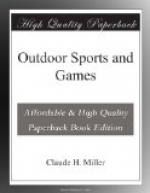Two captains select sides. They then mark out on the ground two bases, or homes. They also mark out two “prisons” near each home base. Then each side stands in its own home and a player runs out and advances toward the enemy’s home. One of the enemy will then run out and endeavour to tag him before he can run back to his own base, and one of his side will try to tag the enemy, the rule being that each in turn must have left his home after his opponent. If a player is tagged, he becomes a prisoner of the other side and is put into the prison. The successful tagger may then return to Ids home without danger of being tagged. A prisoner may be rescued at any time if one of his side can elude the opponents and tag him free from prison. The game ends when all of one side are made prisoners.
PUSH BALL
A game usually played on foot but sometimes on horseback, in which the object is to push or force a huge ball over the opponents’ goal line. A regulation “push ball” is six feet in diameter and costs three hundred dollars.
In push ball almost any number may play, but as weight counts, the sides should be divided as evenly as possible.
QUOITS
A game played with flattish malleable iron or rubber rings about nine inches in diameter and convex on the upper side, which the players endeavour to loss or pitch so that they will encircle a pin or peg driven into the ground, or to come nearer to this peg than their opponents. The peg is called a “hob.” A certain form of quoits is played with horseshoes throughout the country districts of America. A quoit player endeavours to give the quoit such a position in mid-air that it will not roll but will cut into the ground at the point where it lands. The game is remotely similar to the ancient Greek game of throwing the discus. Iron quoits may be purchased for a dollar a set.
The average weight of the quoits used by experts is from seven to nine pounds each. Sixty-one points constitute a game. The distance from the peg shall be either 10, 15 or 18 yards. For a space three feet around the pin or peg the ground should be clay. In match games, all quoits that fall outside a radius of 18 inches from the centre of the pin are “foul,” and do not count in the score.
RACQUETS OR RACKETS
One of the numerous court games similar to lawn tennis that is now finding public favour, but played in a semi-indoor court. A racquet court is 31 feet 6 inches wide and about 63 feet long. The front wall, against which the ball is served, has a line 8 or 10 feet from the floor, above which the ball must strike. The server, as in tennis, takes his position in a service box with a racket similar to a lawn tennis racket except that it has a smaller head and a longer handle.
Either two or four players may play racquets. A game consists of fifteen “aces,” or points.




